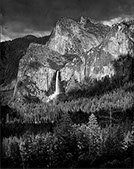Tom Ferderbar PHOTOGRAPHER
A lifetime of photography from the 40's to today.
Yosemite National Park History from the National Park Service website - http://www.nps.gov/yose/nature/history.htm
American Indians
Indian people have lived in the Yosemite region for as long as 8,000 years. By the mid-nineteenth century, when native residents had their first contact with non-Indian people, they were primarily of Southern Miwok ancestry. However, trade with the Mono Paiutes from the east side of the Sierra for pinyon pine nuts, obsidian, and other materials from the Mono Basin resulted in many unions between the two tribes.The native people of Yosemite developed a complex culture rich in tradition, religion, songs, and political affiliations. Making use of the varied local ecosystems, they used plant and animal resources to the best of their abilities. The pattern of oaks and grassland noted by early visitors to Yosemite Valley is probably a direct result of the intentional burning of underbrush practiced by native people.Mariposa Battalion Enters Yosemite Valley
Mariposa Batallion Enters Yosemite Valley
Although the first sighting of Yosemite Valley by non-Indian people was probably by members of the Joseph Walker Party in 1833, the first actual known entry into the Valley was not until nearly 20 years later. After the discovery of gold in the Sierra Nevada foothills in 1849, thousands of miners came to the Sierra to seek their fortune. Their arrival resulted in conflict with local native people who fought to protect their homelands. Because of such interaction, the Mariposa Battalion was organized as a punitive expedition under the authority of the State of California to bring an end to the "Mariposa Indian War." The Battalion entered Yosemite Valley while searching for Indians on March 27, 1851.
Early Tourists and Settlers
Writers, artists and photographers spread the fame of "the Incomparable Valley" throughout the world. A steadily increasing stream of visitors came on foot and horseback, and later by stage. Realizing he could make money off the tourism, James Hutchings became one of Yosemite's first entrepeneuers. Hotels and residences were constructed, livestock grazed in meadows, orchards were planted, and as a result, Yosemite Valley's ecosystem suffered.
Protection is Sought for Yosemite
Inspired by the scenic beauty of Yosemite and spurred on by the specter of private exploitation of Yosemite's natural wonders, conservationists appealed to Senator John Conness of California. On June 30, 1864, President Abraham Lincoln signed a bill granting Yosemite Valley and the Mariposa Grove of Giant Sequoias to the State of California as an inalienable public trust. This was the first time in history that a federal government had set aside scenic lands simply to protect them and to allow for their enjoyment by all people. This idea was the spark that allowed for Yellowstone becoming the first official national park a few years later, in 1872.
Later, John Muir's struggle against the devastation of the subalpine meadows surrounding Yosemite Valley resulted in the creation of Yosemite National Park on October 1, 1890. Military units with headquarters in Wawona administered the park while the State of California continued to govern the area covered by the original 1864 grant. Dual control of Yosemite came to an end in 1906, when the State of California receded Yosemite Valley and the Mariposa Grove to the federal government. Civilian park rangers took over from the military in 1914. Two years later, on August 25, 1916, through the persistent efforts of Steven Mather and Horace Albright, Congress authorized the creation of the National Park Service to administer all national parks "in such manner and by such means as to leave them unimpaired for the enjoyment of future generations." Around the turn of the century, Hetch Hetchy Valley became the center of a bitter political struggle when the City of San Francisco wanted to dam the Tuolumne River inside Yosemite National Park as a source of drinking water and hydroelectric power. In 1913, conservationists led by John Muir lost the battle when Congress passed the Raker Act, authorizing the construction of O'Shaughnessy Dam.
Increasing Visitation Requires Management Plans
The day of the horse-drawn stage drew to a close in 1907 with the construction of the Yosemite Valley Railroad from Merced to El Portal. While a few automobiles entered the park in 1900 and 1901, they were not officially permitted until 1913. In 1925, two major concessioners were consolidated into the Yosemite Park and Curry Company in order to reduce competitive expansion of facilities in the park.
Impacts resulting from increasing visitation in Yosemite Valley became apparent. People camped throughout meadows and dramatically increasing automobile traffic driving on unpaved roads left the Valley dull with dust each summer. As visitation and need for year-round services increased, Yosemite Village was relocated from a location in the floodplain on the south side of the Merced River to the present Yosemite Village site to the north.
Visitation exceeded one million in 1954 for the first time, and by 1976 over two million people visited Yosemite. In the mid-1990s, visitation topped four million. In the early 1970s, the National Park Service established one-way road traffic patterns, eliminated cars in the far east end of the Valley, offered free shuttle bus transportation in the Valley, converted the parking lot in front of the Valley Visitor Center to a pedestrian mall, and generally encouraged visitors to enjoy the park by walking or using public transportation.
Yosemite's General Management Plan, which was completed in 1980, articulated the needs for parkwide visitor services, resources management, interpretation services, concessions management, and park operations. Implementation of the General Management Plan is ongoing, with the Yosemite Valley Plan providing specific and detailed actions to implement the General Management Plan in Yosemite Valley.
copyright 2020 Thomas Ferderbar
